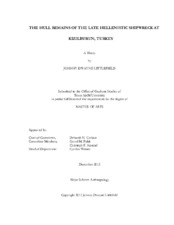| dc.description.abstract | At least 64 shipwrecked stone transports have been discovered throughout the Mediterranean region dating primarily to the Roman period. Few have been excavated and even fewer have had more than scant hull remains recovered. None have been thoroughly examined with a focus on the construction of the vessel. Consequently, little is known about stone transport or the construction of stone transport ships from archaeological contexts or ancient historical sources.
In 1993, on an Institute of Nautical Archaeology (INA) shipwreck survey along the western Turkish coast, the Kızılburun column wreck was discovered. At present, excavated ceramics suggest the date of the Kızılburun shipwreck lies in the first century B.C.E.; the Late Hellenistic period (323-31 BCE). Analyses of the marble consignment have revealed that the ship carried a primary cargo of architectural elements quarried on the island of Proconnesus. Subsequent investigations point to a likely destination of the ancient city of Claros on the Karian coast of Asia Minor (modern day Turkey).
Between 2005 and 2011 excavations were carried out on the column wreck by an international team of archaeologists, INA staff members, and graduate students led by Donny Hamilton and Deborah Carlson, both of Texas A&M University. The 2005 excavation season produced the first, albeit scant, hull remains, with more timbers being recovered between 2006 and 2009. The most substantial hull remains were recovered in 2007 following the removal of the eight large marble column drums to a more remote part of the site. The intense weight and pressure exerted by the heavy cargo on the hull remains aided the preservation by creating an environment that was unfavorable for wood consuming organisms and other biological agents.
Recording and detailed examination of the hull remains was conducted during the summer of 2008, fall of 2009, and fall of 2010. This thesis presents the analyses and interpretation of the Kızılburun ship’s wooden hull remains and copper fasteners. Additionally, after discussing the methods of recording and cataloging of the ship’s extant remains, I place the ship in its historical and technological contexts, demonstrating that it was of contemporaneously common dimensions and construction, as opposed to a more robust construction that is often assumed of ancient stone-carrying vessels. | en |


